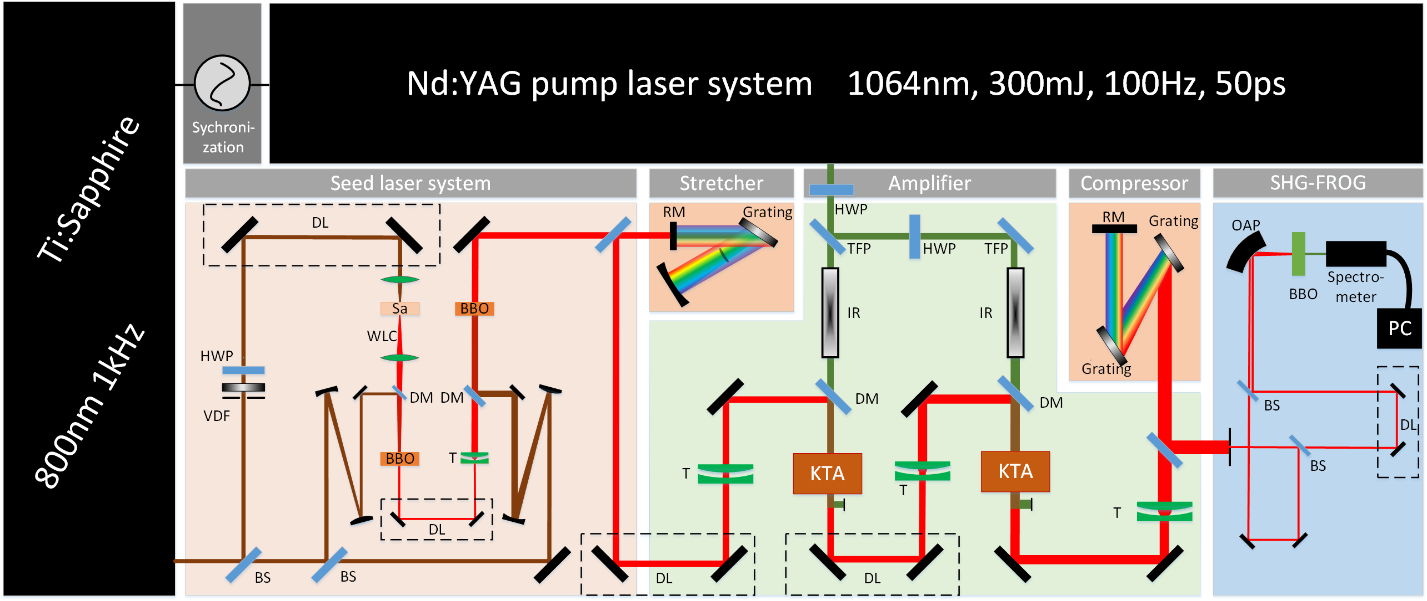High-order harmonic generation (HHG) has been attracting increasing attention due to its excellent properties of high peak intensity and brightness, full coherence, wide tunability, and creation of isolated attosecond pulses. Aiming to extend the HHG cut-off energy and obtain high efficiency simultaneously, the development of high-peak-power high-repetition-rate carrier-envelope phase (CEP)-stabilized near-infrared laser systems becomes more imperative.
Recently, researchers from Shanghai Institute of Optics and Fine Mechanics of the Chinese Academy of Sciences (CAS) employed the optical parametric chirped pulse amplification (OPCPA) technology to generate 26.5 mJ/60 fs with the center wavelength of 1450 nm and a high-repetition rate of 100 Hz. The results were published on High Power Laser Science and Engineering.
In their experiment, the high-peak-power laser system includes a commercial 1 kHz Ti:sapphire chirped pulse amplification (CPA) laser, a home-built BBO-based OPA seed laser system, an offner stretcher, an OPCPA amplifier, a home-built Nd:YAG pump laser system, a two-grating compressor and a home-built second-harmonic generation frequency-resolved optical gating (SHG-FROG) measurement device, as shown in Figure 1.
The 1450 nm pulse output from the BBO-based OPA seed laser system is with 190 uJ energy. Afterwards, the pulse was stretched to 50 ps (full width at half maximum, FWHM) in the offner-type stretcher and then amplified to more than 40 mJ energy by the OPCPA amplifier based on two 10-mm-thick KTA crystals. Finally, the high-energy 1450 nm pulse was compressed to 26.5 mJ/60 fs in the two-grating compressor. It is worth noting that all of the OPCPA system and the pulse diagnostic device are home-built except the pump laser of the initial BBO-based OPA seed laser system (the commercial 1 kHz Ti:sapphire chirped pulse amplification (CPA) laser).
The home-built OPCPA laser system has a series of excellent parameters such as high-energy (26.5 mJ), high-peak-power (0.33 TW), high-repetition frequency (100 Hz), potential stable CEP and long wavelength at 1450nm. It is one of the best laser systems at 1450 nm wavelength and is suitable for driving various nonlinear optical phenomena in such fields as high harmonic generation to obtain high flux ultrafast soft X-ray pulses and the generation of intense single cycle THz pulses through driving plasma emission.
This work is funded by the Strategic Priority Research Program of the Chinese Academy of Sciences (Grant No. XDB1603), the National Natural Science Foundation of China (Grant No. 11127901, 61521093, 61635012), International S&T Cooperation Program of China (Grant No. 2016YFE0119300), Program of Shanghai Academic/Technology Research Leader (Grant No. 18XD1404200) and Shanghai Municipal Science and Technology Major Project (Grant No. 2017SHZDZX02).

Figure 1. Schematic of the OPCPA setup.(Image by SIOM)

Figure 2. Temporal characterization of the compressed pulse. (Image by SIOM)
Article website:
http://www.clp.ac.cn/EN/Article/OJc02bcddefcbb8627?type=html
Contact:
Mr. Cao Yong
General Administrative Office
Shanghai Institute of Optics and Fine Mechanics, CAS
Email: caoyong@siom.ac.cn